MGMT301: WL Gore & Associates - Competitive Strategy Management Report
VerifiedAdded on 2022/08/31
|11
|2907
|19
Report
AI Summary
This report provides a comprehensive analysis of WL Gore & Associates' management strategies, organizational structure, and their impact on employee motivation, innovation, and creativity. The report begins by identifying the distinctive features of WL Gore's management system, including its lattice structure and emphasis on employee engagement, and how these features are based on identifiable management principles. It then evaluates the advantages and disadvantages of WL Gore's approach, focusing on its ability to foster both formal and informal connections, promote teamwork, and encourage innovation. The analysis also considers the limitations of the system, such as potential conflicts and outdated management structures. Finally, the report assesses the transferability of WL Gore's approach to other companies, suggesting its suitability for partnership-working companies and those with democratic leadership styles. The report concludes with recommendations for implementing reward management systems and fostering employee development.
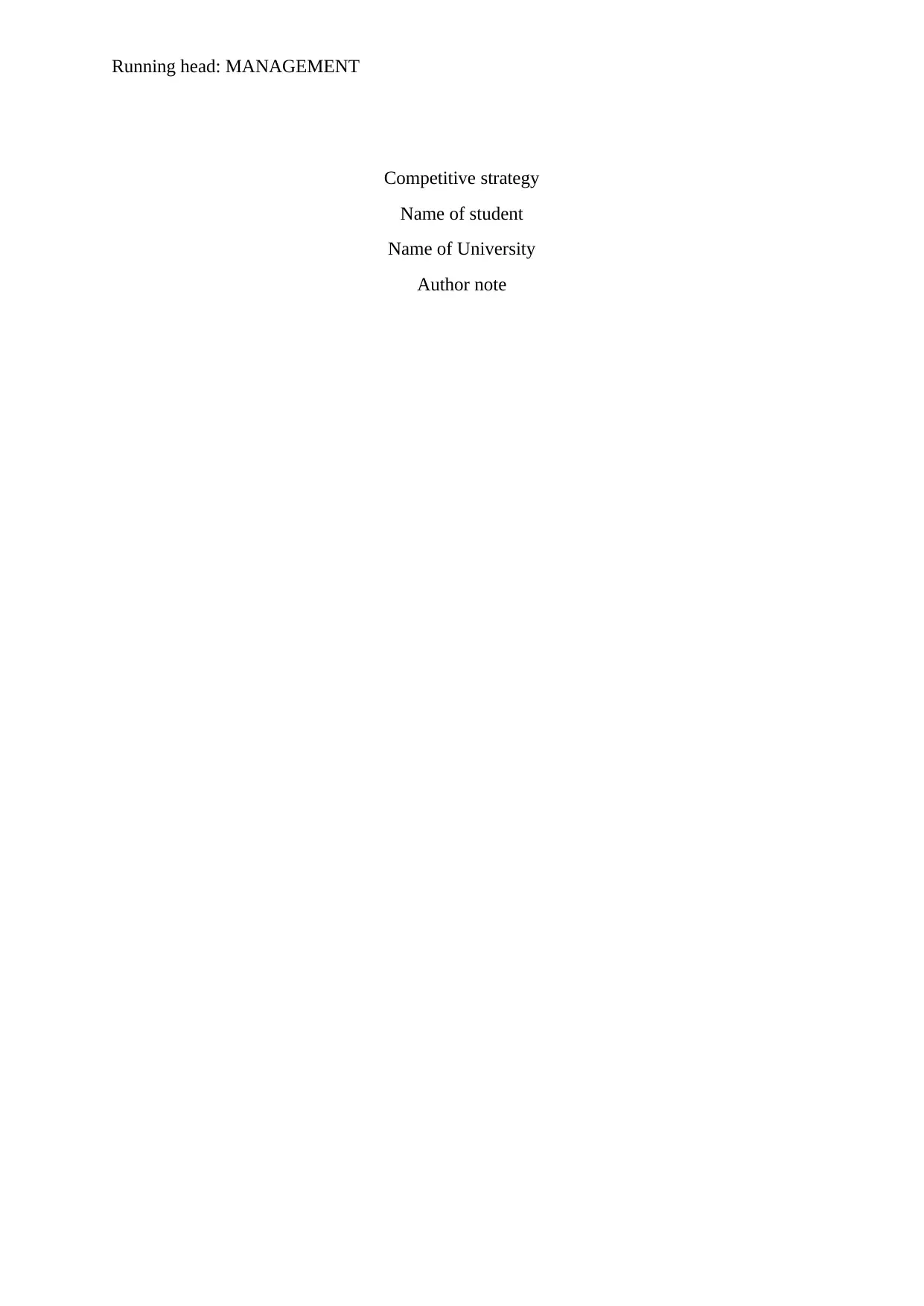
Running head: MANAGEMENT
Competitive strategy
Name of student
Name of University
Author note
Competitive strategy
Name of student
Name of University
Author note
Paraphrase This Document
Need a fresh take? Get an instant paraphrase of this document with our AI Paraphraser
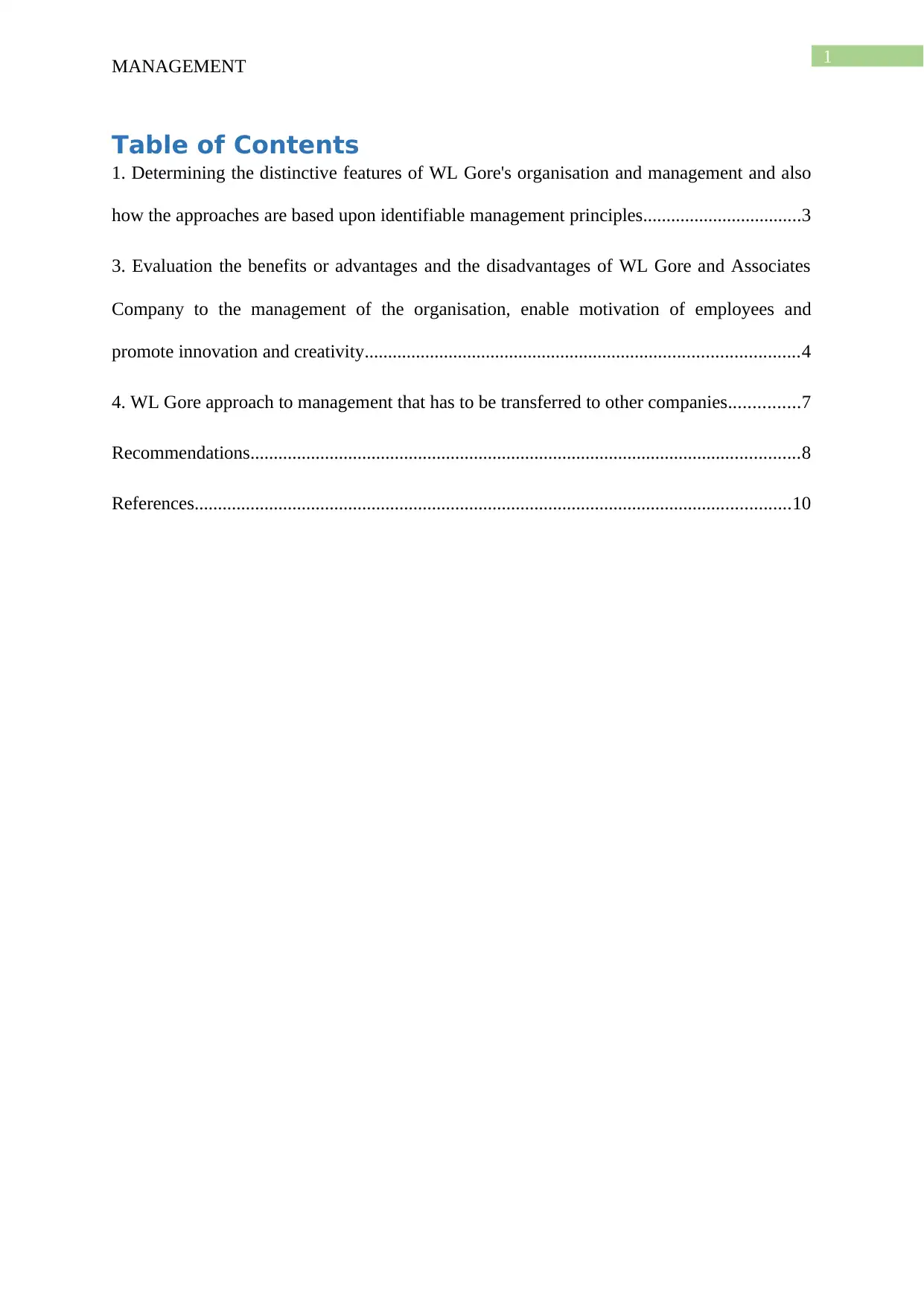
1
MANAGEMENT
Table of Contents
1. Determining the distinctive features of WL Gore's organisation and management and also
how the approaches are based upon identifiable management principles..................................3
3. Evaluation the benefits or advantages and the disadvantages of WL Gore and Associates
Company to the management of the organisation, enable motivation of employees and
promote innovation and creativity.............................................................................................4
4. WL Gore approach to management that has to be transferred to other companies...............7
Recommendations......................................................................................................................8
References................................................................................................................................10
MANAGEMENT
Table of Contents
1. Determining the distinctive features of WL Gore's organisation and management and also
how the approaches are based upon identifiable management principles..................................3
3. Evaluation the benefits or advantages and the disadvantages of WL Gore and Associates
Company to the management of the organisation, enable motivation of employees and
promote innovation and creativity.............................................................................................4
4. WL Gore approach to management that has to be transferred to other companies...............7
Recommendations......................................................................................................................8
References................................................................................................................................10
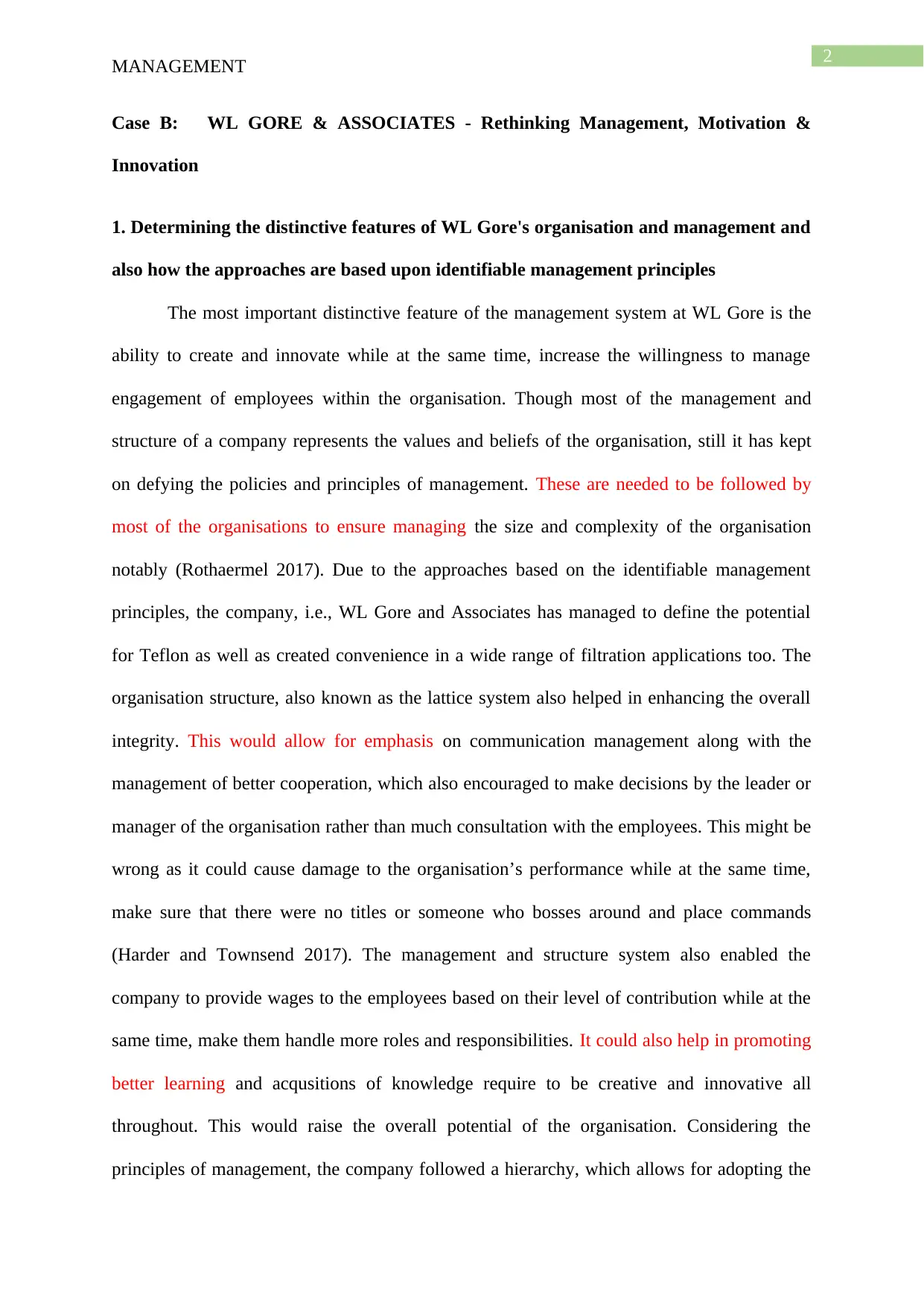
2
MANAGEMENT
Case B: WL GORE & ASSOCIATES - Rethinking Management, Motivation &
Innovation
1. Determining the distinctive features of WL Gore's organisation and management and
also how the approaches are based upon identifiable management principles
The most important distinctive feature of the management system at WL Gore is the
ability to create and innovate while at the same time, increase the willingness to manage
engagement of employees within the organisation. Though most of the management and
structure of a company represents the values and beliefs of the organisation, still it has kept
on defying the policies and principles of management. These are needed to be followed by
most of the organisations to ensure managing the size and complexity of the organisation
notably (Rothaermel 2017). Due to the approaches based on the identifiable management
principles, the company, i.e., WL Gore and Associates has managed to define the potential
for Teflon as well as created convenience in a wide range of filtration applications too. The
organisation structure, also known as the lattice system also helped in enhancing the overall
integrity. This would allow for emphasis on communication management along with the
management of better cooperation, which also encouraged to make decisions by the leader or
manager of the organisation rather than much consultation with the employees. This might be
wrong as it could cause damage to the organisation’s performance while at the same time,
make sure that there were no titles or someone who bosses around and place commands
(Harder and Townsend 2017). The management and structure system also enabled the
company to provide wages to the employees based on their level of contribution while at the
same time, make them handle more roles and responsibilities. It could also help in promoting
better learning and acqusitions of knowledge require to be creative and innovative all
throughout. This would raise the overall potential of the organisation. Considering the
principles of management, the company followed a hierarchy, which allows for adopting the
MANAGEMENT
Case B: WL GORE & ASSOCIATES - Rethinking Management, Motivation &
Innovation
1. Determining the distinctive features of WL Gore's organisation and management and
also how the approaches are based upon identifiable management principles
The most important distinctive feature of the management system at WL Gore is the
ability to create and innovate while at the same time, increase the willingness to manage
engagement of employees within the organisation. Though most of the management and
structure of a company represents the values and beliefs of the organisation, still it has kept
on defying the policies and principles of management. These are needed to be followed by
most of the organisations to ensure managing the size and complexity of the organisation
notably (Rothaermel 2017). Due to the approaches based on the identifiable management
principles, the company, i.e., WL Gore and Associates has managed to define the potential
for Teflon as well as created convenience in a wide range of filtration applications too. The
organisation structure, also known as the lattice system also helped in enhancing the overall
integrity. This would allow for emphasis on communication management along with the
management of better cooperation, which also encouraged to make decisions by the leader or
manager of the organisation rather than much consultation with the employees. This might be
wrong as it could cause damage to the organisation’s performance while at the same time,
make sure that there were no titles or someone who bosses around and place commands
(Harder and Townsend 2017). The management and structure system also enabled the
company to provide wages to the employees based on their level of contribution while at the
same time, make them handle more roles and responsibilities. It could also help in promoting
better learning and acqusitions of knowledge require to be creative and innovative all
throughout. This would raise the overall potential of the organisation. Considering the
principles of management, the company followed a hierarchy, which allows for adopting the
⊘ This is a preview!⊘
Do you want full access?
Subscribe today to unlock all pages.

Trusted by 1+ million students worldwide
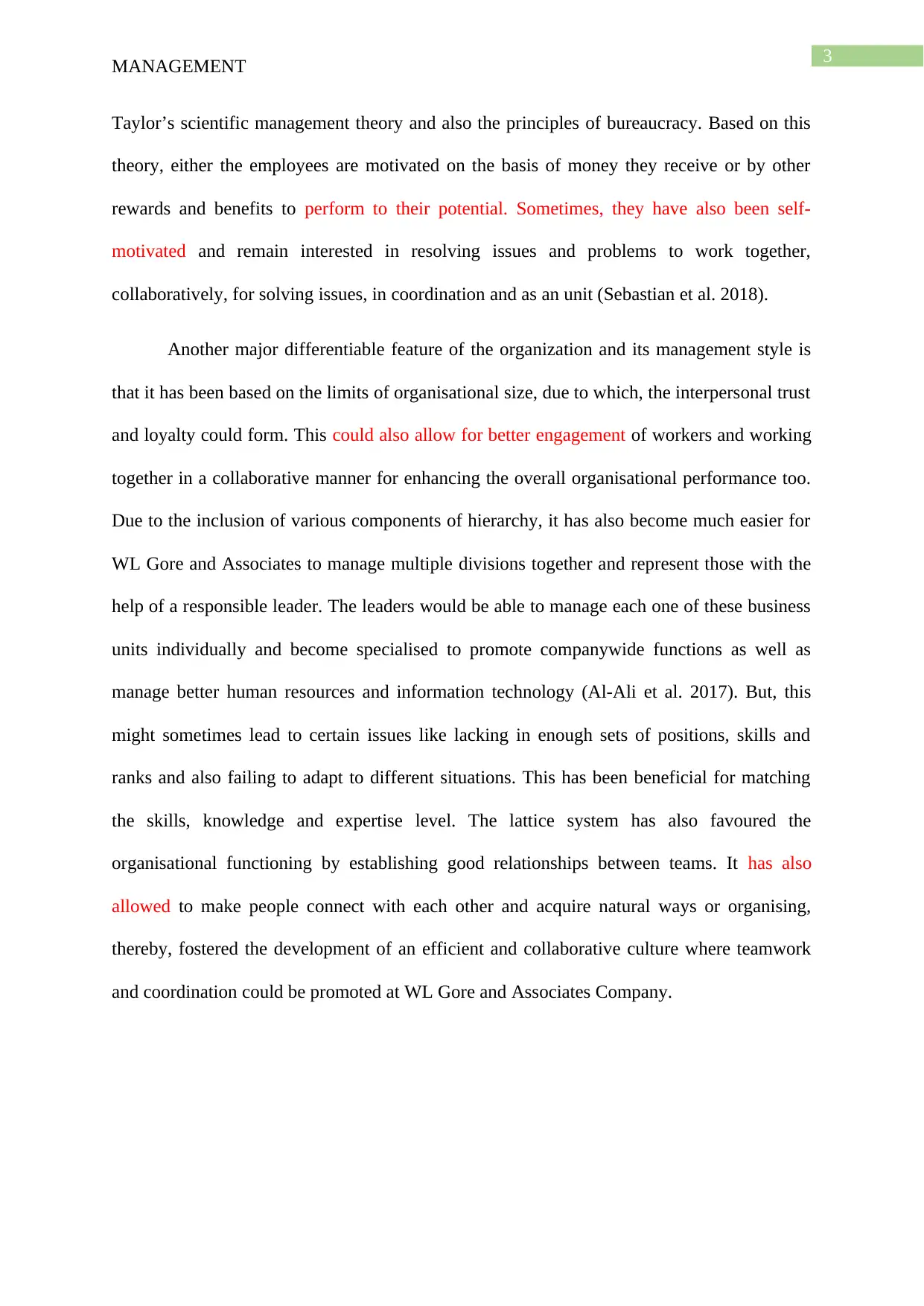
3
MANAGEMENT
Taylor’s scientific management theory and also the principles of bureaucracy. Based on this
theory, either the employees are motivated on the basis of money they receive or by other
rewards and benefits to perform to their potential. Sometimes, they have also been self-
motivated and remain interested in resolving issues and problems to work together,
collaboratively, for solving issues, in coordination and as an unit (Sebastian et al. 2018).
Another major differentiable feature of the organization and its management style is
that it has been based on the limits of organisational size, due to which, the interpersonal trust
and loyalty could form. This could also allow for better engagement of workers and working
together in a collaborative manner for enhancing the overall organisational performance too.
Due to the inclusion of various components of hierarchy, it has also become much easier for
WL Gore and Associates to manage multiple divisions together and represent those with the
help of a responsible leader. The leaders would be able to manage each one of these business
units individually and become specialised to promote companywide functions as well as
manage better human resources and information technology (Al-Ali et al. 2017). But, this
might sometimes lead to certain issues like lacking in enough sets of positions, skills and
ranks and also failing to adapt to different situations. This has been beneficial for matching
the skills, knowledge and expertise level. The lattice system has also favoured the
organisational functioning by establishing good relationships between teams. It has also
allowed to make people connect with each other and acquire natural ways or organising,
thereby, fostered the development of an efficient and collaborative culture where teamwork
and coordination could be promoted at WL Gore and Associates Company.
MANAGEMENT
Taylor’s scientific management theory and also the principles of bureaucracy. Based on this
theory, either the employees are motivated on the basis of money they receive or by other
rewards and benefits to perform to their potential. Sometimes, they have also been self-
motivated and remain interested in resolving issues and problems to work together,
collaboratively, for solving issues, in coordination and as an unit (Sebastian et al. 2018).
Another major differentiable feature of the organization and its management style is
that it has been based on the limits of organisational size, due to which, the interpersonal trust
and loyalty could form. This could also allow for better engagement of workers and working
together in a collaborative manner for enhancing the overall organisational performance too.
Due to the inclusion of various components of hierarchy, it has also become much easier for
WL Gore and Associates to manage multiple divisions together and represent those with the
help of a responsible leader. The leaders would be able to manage each one of these business
units individually and become specialised to promote companywide functions as well as
manage better human resources and information technology (Al-Ali et al. 2017). But, this
might sometimes lead to certain issues like lacking in enough sets of positions, skills and
ranks and also failing to adapt to different situations. This has been beneficial for matching
the skills, knowledge and expertise level. The lattice system has also favoured the
organisational functioning by establishing good relationships between teams. It has also
allowed to make people connect with each other and acquire natural ways or organising,
thereby, fostered the development of an efficient and collaborative culture where teamwork
and coordination could be promoted at WL Gore and Associates Company.
Paraphrase This Document
Need a fresh take? Get an instant paraphrase of this document with our AI Paraphraser
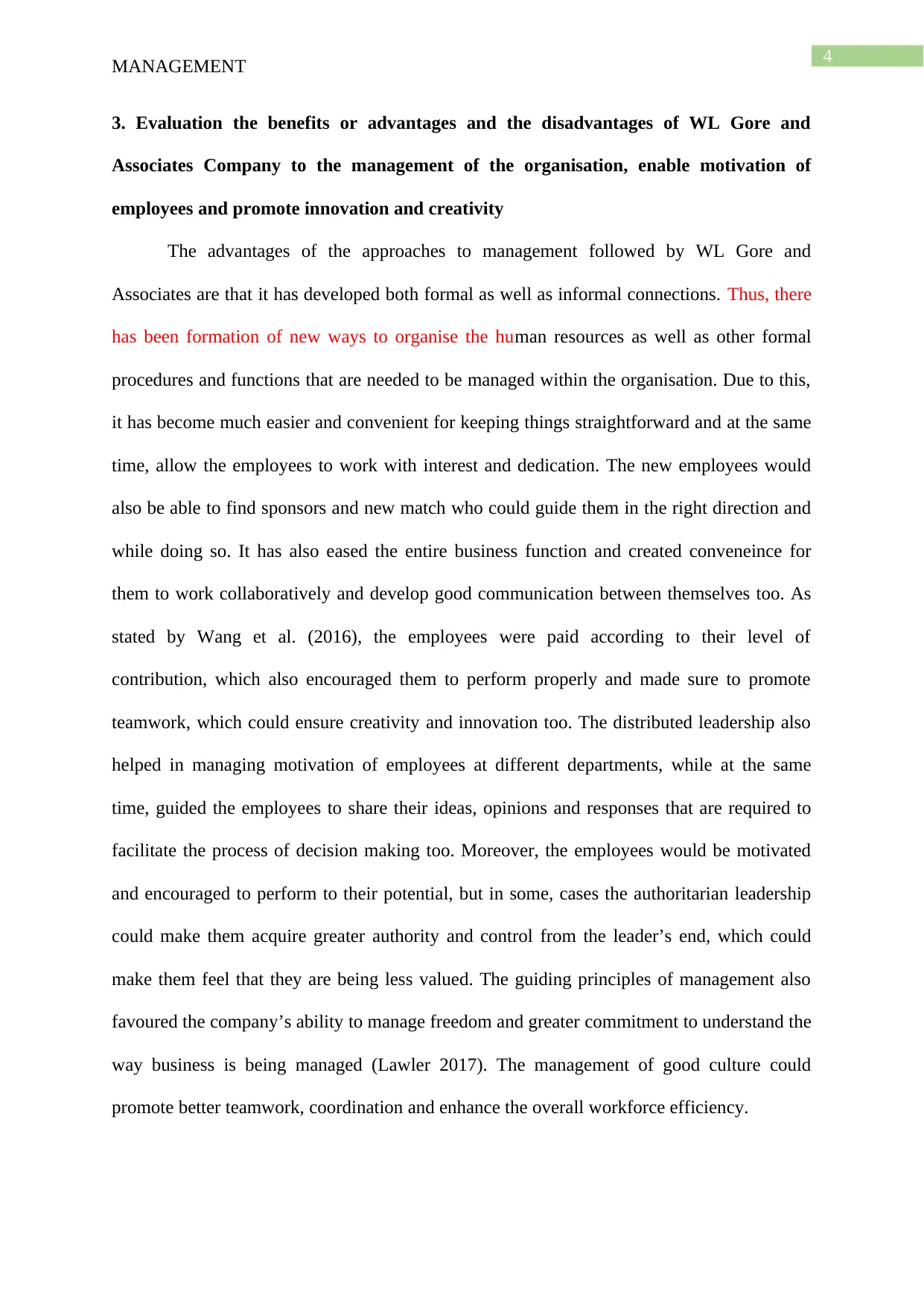
4
MANAGEMENT
3. Evaluation the benefits or advantages and the disadvantages of WL Gore and
Associates Company to the management of the organisation, enable motivation of
employees and promote innovation and creativity
The advantages of the approaches to management followed by WL Gore and
Associates are that it has developed both formal as well as informal connections. Thus, there
has been formation of new ways to organise the human resources as well as other formal
procedures and functions that are needed to be managed within the organisation. Due to this,
it has become much easier and convenient for keeping things straightforward and at the same
time, allow the employees to work with interest and dedication. The new employees would
also be able to find sponsors and new match who could guide them in the right direction and
while doing so. It has also eased the entire business function and created conveneince for
them to work collaboratively and develop good communication between themselves too. As
stated by Wang et al. (2016), the employees were paid according to their level of
contribution, which also encouraged them to perform properly and made sure to promote
teamwork, which could ensure creativity and innovation too. The distributed leadership also
helped in managing motivation of employees at different departments, while at the same
time, guided the employees to share their ideas, opinions and responses that are required to
facilitate the process of decision making too. Moreover, the employees would be motivated
and encouraged to perform to their potential, but in some, cases the authoritarian leadership
could make them acquire greater authority and control from the leader’s end, which could
make them feel that they are being less valued. The guiding principles of management also
favoured the company’s ability to manage freedom and greater commitment to understand the
way business is being managed (Lawler 2017). The management of good culture could
promote better teamwork, coordination and enhance the overall workforce efficiency.
MANAGEMENT
3. Evaluation the benefits or advantages and the disadvantages of WL Gore and
Associates Company to the management of the organisation, enable motivation of
employees and promote innovation and creativity
The advantages of the approaches to management followed by WL Gore and
Associates are that it has developed both formal as well as informal connections. Thus, there
has been formation of new ways to organise the human resources as well as other formal
procedures and functions that are needed to be managed within the organisation. Due to this,
it has become much easier and convenient for keeping things straightforward and at the same
time, allow the employees to work with interest and dedication. The new employees would
also be able to find sponsors and new match who could guide them in the right direction and
while doing so. It has also eased the entire business function and created conveneince for
them to work collaboratively and develop good communication between themselves too. As
stated by Wang et al. (2016), the employees were paid according to their level of
contribution, which also encouraged them to perform properly and made sure to promote
teamwork, which could ensure creativity and innovation too. The distributed leadership also
helped in managing motivation of employees at different departments, while at the same
time, guided the employees to share their ideas, opinions and responses that are required to
facilitate the process of decision making too. Moreover, the employees would be motivated
and encouraged to perform to their potential, but in some, cases the authoritarian leadership
could make them acquire greater authority and control from the leader’s end, which could
make them feel that they are being less valued. The guiding principles of management also
favoured the company’s ability to manage freedom and greater commitment to understand the
way business is being managed (Lawler 2017). The management of good culture could
promote better teamwork, coordination and enhance the overall workforce efficiency.
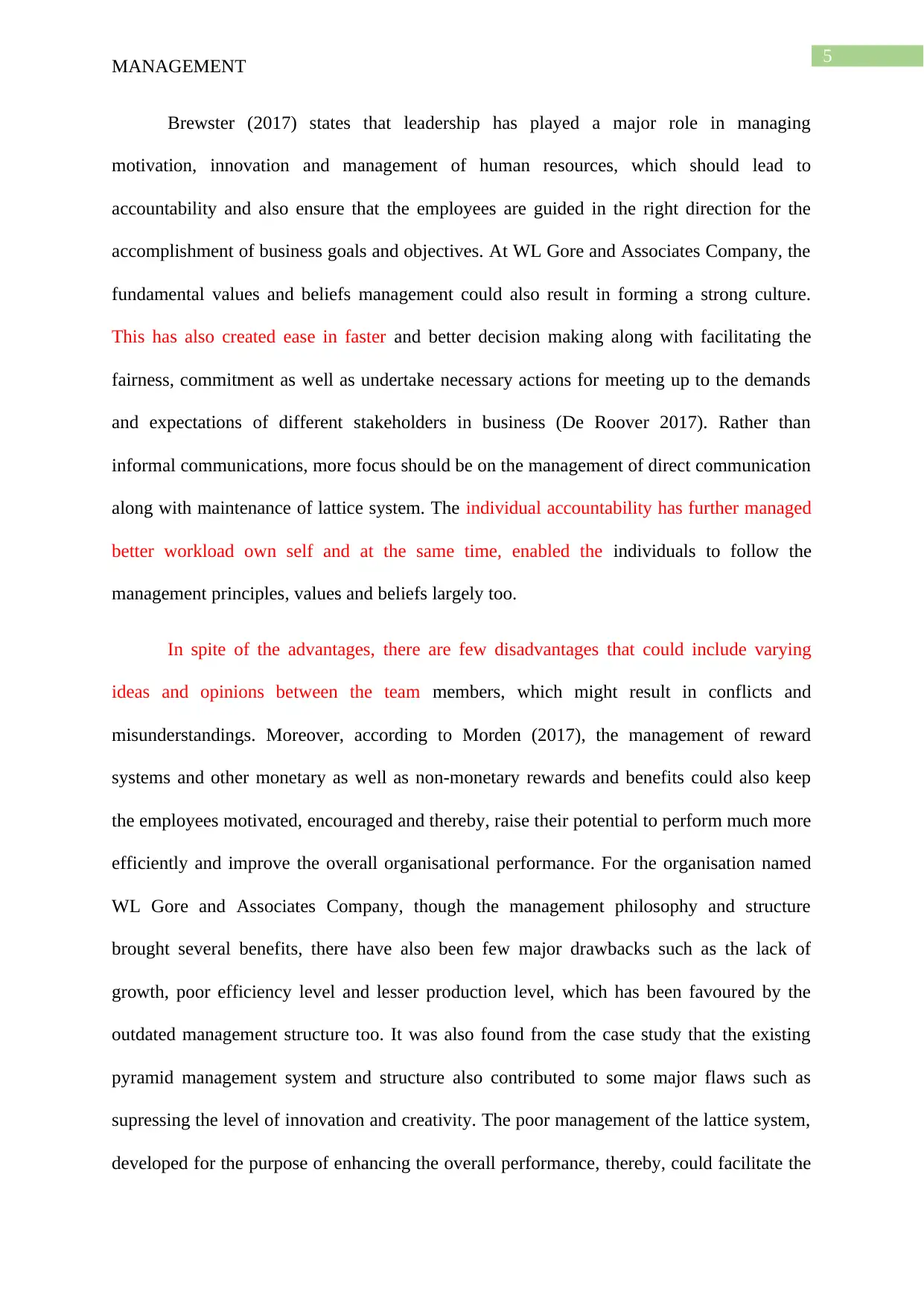
5
MANAGEMENT
Brewster (2017) states that leadership has played a major role in managing
motivation, innovation and management of human resources, which should lead to
accountability and also ensure that the employees are guided in the right direction for the
accomplishment of business goals and objectives. At WL Gore and Associates Company, the
fundamental values and beliefs management could also result in forming a strong culture.
This has also created ease in faster and better decision making along with facilitating the
fairness, commitment as well as undertake necessary actions for meeting up to the demands
and expectations of different stakeholders in business (De Roover 2017). Rather than
informal communications, more focus should be on the management of direct communication
along with maintenance of lattice system. The individual accountability has further managed
better workload own self and at the same time, enabled the individuals to follow the
management principles, values and beliefs largely too.
In spite of the advantages, there are few disadvantages that could include varying
ideas and opinions between the team members, which might result in conflicts and
misunderstandings. Moreover, according to Morden (2017), the management of reward
systems and other monetary as well as non-monetary rewards and benefits could also keep
the employees motivated, encouraged and thereby, raise their potential to perform much more
efficiently and improve the overall organisational performance. For the organisation named
WL Gore and Associates Company, though the management philosophy and structure
brought several benefits, there have also been few major drawbacks such as the lack of
growth, poor efficiency level and lesser production level, which has been favoured by the
outdated management structure too. It was also found from the case study that the existing
pyramid management system and structure also contributed to some major flaws such as
supressing the level of innovation and creativity. The poor management of the lattice system,
developed for the purpose of enhancing the overall performance, thereby, could facilitate the
MANAGEMENT
Brewster (2017) states that leadership has played a major role in managing
motivation, innovation and management of human resources, which should lead to
accountability and also ensure that the employees are guided in the right direction for the
accomplishment of business goals and objectives. At WL Gore and Associates Company, the
fundamental values and beliefs management could also result in forming a strong culture.
This has also created ease in faster and better decision making along with facilitating the
fairness, commitment as well as undertake necessary actions for meeting up to the demands
and expectations of different stakeholders in business (De Roover 2017). Rather than
informal communications, more focus should be on the management of direct communication
along with maintenance of lattice system. The individual accountability has further managed
better workload own self and at the same time, enabled the individuals to follow the
management principles, values and beliefs largely too.
In spite of the advantages, there are few disadvantages that could include varying
ideas and opinions between the team members, which might result in conflicts and
misunderstandings. Moreover, according to Morden (2017), the management of reward
systems and other monetary as well as non-monetary rewards and benefits could also keep
the employees motivated, encouraged and thereby, raise their potential to perform much more
efficiently and improve the overall organisational performance. For the organisation named
WL Gore and Associates Company, though the management philosophy and structure
brought several benefits, there have also been few major drawbacks such as the lack of
growth, poor efficiency level and lesser production level, which has been favoured by the
outdated management structure too. It was also found from the case study that the existing
pyramid management system and structure also contributed to some major flaws such as
supressing the level of innovation and creativity. The poor management of the lattice system,
developed for the purpose of enhancing the overall performance, thereby, could facilitate the
⊘ This is a preview!⊘
Do you want full access?
Subscribe today to unlock all pages.

Trusted by 1+ million students worldwide
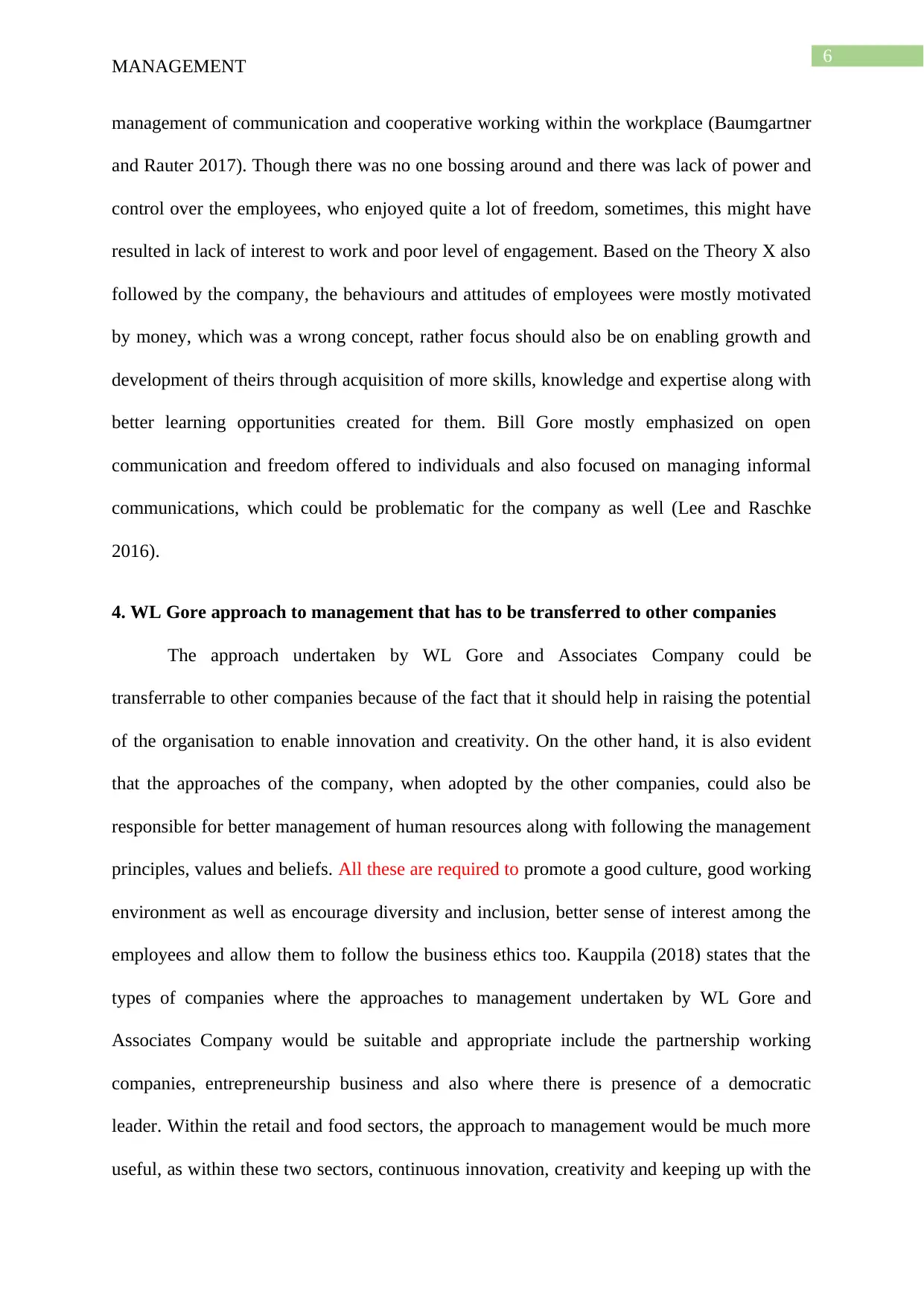
6
MANAGEMENT
management of communication and cooperative working within the workplace (Baumgartner
and Rauter 2017). Though there was no one bossing around and there was lack of power and
control over the employees, who enjoyed quite a lot of freedom, sometimes, this might have
resulted in lack of interest to work and poor level of engagement. Based on the Theory X also
followed by the company, the behaviours and attitudes of employees were mostly motivated
by money, which was a wrong concept, rather focus should also be on enabling growth and
development of theirs through acquisition of more skills, knowledge and expertise along with
better learning opportunities created for them. Bill Gore mostly emphasized on open
communication and freedom offered to individuals and also focused on managing informal
communications, which could be problematic for the company as well (Lee and Raschke
2016).
4. WL Gore approach to management that has to be transferred to other companies
The approach undertaken by WL Gore and Associates Company could be
transferrable to other companies because of the fact that it should help in raising the potential
of the organisation to enable innovation and creativity. On the other hand, it is also evident
that the approaches of the company, when adopted by the other companies, could also be
responsible for better management of human resources along with following the management
principles, values and beliefs. All these are required to promote a good culture, good working
environment as well as encourage diversity and inclusion, better sense of interest among the
employees and allow them to follow the business ethics too. Kauppila (2018) states that the
types of companies where the approaches to management undertaken by WL Gore and
Associates Company would be suitable and appropriate include the partnership working
companies, entrepreneurship business and also where there is presence of a democratic
leader. Within the retail and food sectors, the approach to management would be much more
useful, as within these two sectors, continuous innovation, creativity and keeping up with the
MANAGEMENT
management of communication and cooperative working within the workplace (Baumgartner
and Rauter 2017). Though there was no one bossing around and there was lack of power and
control over the employees, who enjoyed quite a lot of freedom, sometimes, this might have
resulted in lack of interest to work and poor level of engagement. Based on the Theory X also
followed by the company, the behaviours and attitudes of employees were mostly motivated
by money, which was a wrong concept, rather focus should also be on enabling growth and
development of theirs through acquisition of more skills, knowledge and expertise along with
better learning opportunities created for them. Bill Gore mostly emphasized on open
communication and freedom offered to individuals and also focused on managing informal
communications, which could be problematic for the company as well (Lee and Raschke
2016).
4. WL Gore approach to management that has to be transferred to other companies
The approach undertaken by WL Gore and Associates Company could be
transferrable to other companies because of the fact that it should help in raising the potential
of the organisation to enable innovation and creativity. On the other hand, it is also evident
that the approaches of the company, when adopted by the other companies, could also be
responsible for better management of human resources along with following the management
principles, values and beliefs. All these are required to promote a good culture, good working
environment as well as encourage diversity and inclusion, better sense of interest among the
employees and allow them to follow the business ethics too. Kauppila (2018) states that the
types of companies where the approaches to management undertaken by WL Gore and
Associates Company would be suitable and appropriate include the partnership working
companies, entrepreneurship business and also where there is presence of a democratic
leader. Within the retail and food sectors, the approach to management would be much more
useful, as within these two sectors, continuous innovation, creativity and keeping up with the
Paraphrase This Document
Need a fresh take? Get an instant paraphrase of this document with our AI Paraphraser
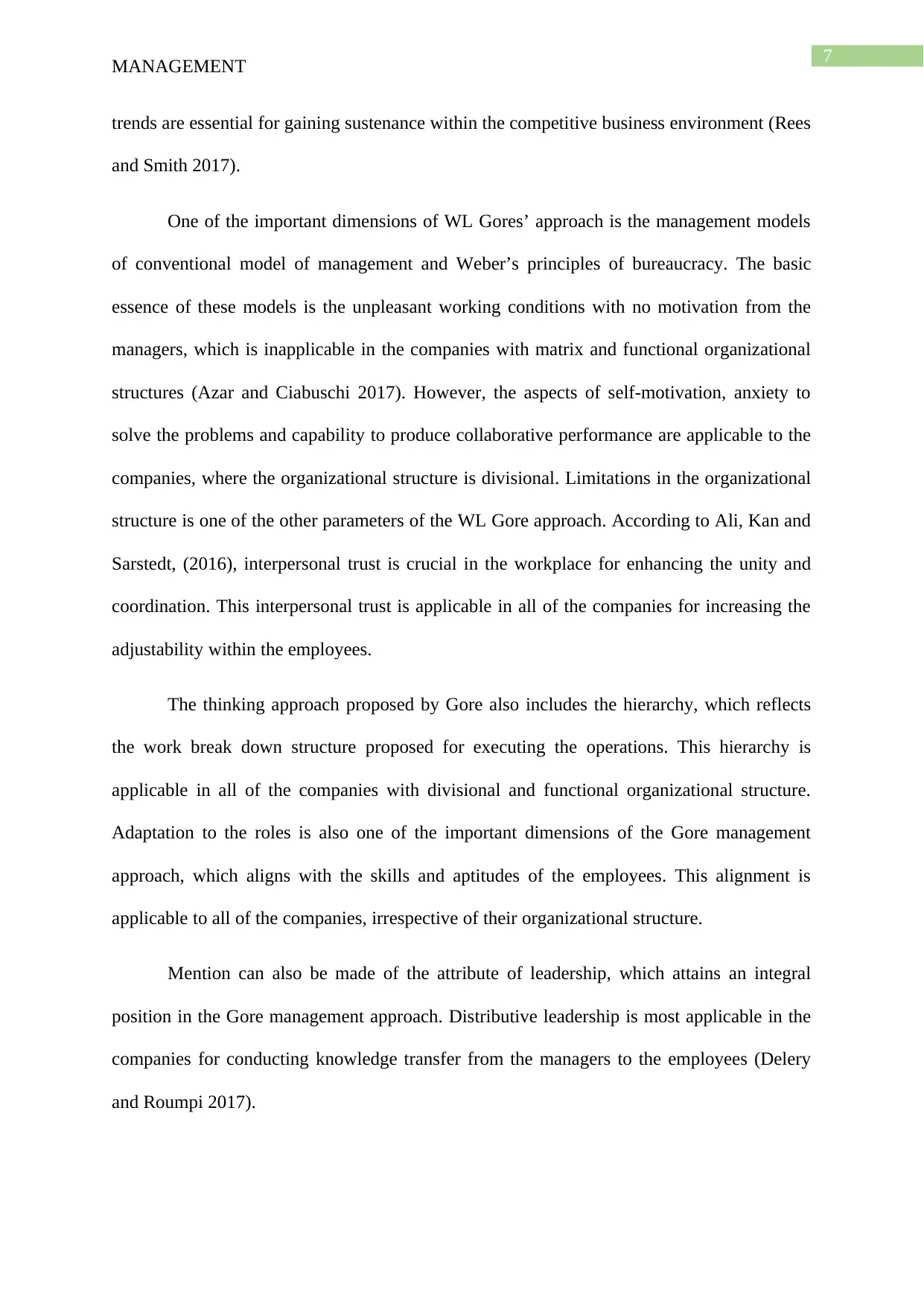
7
MANAGEMENT
trends are essential for gaining sustenance within the competitive business environment (Rees
and Smith 2017).
One of the important dimensions of WL Gores’ approach is the management models
of conventional model of management and Weber’s principles of bureaucracy. The basic
essence of these models is the unpleasant working conditions with no motivation from the
managers, which is inapplicable in the companies with matrix and functional organizational
structures (Azar and Ciabuschi 2017). However, the aspects of self-motivation, anxiety to
solve the problems and capability to produce collaborative performance are applicable to the
companies, where the organizational structure is divisional. Limitations in the organizational
structure is one of the other parameters of the WL Gore approach. According to Ali, Kan and
Sarstedt, (2016), interpersonal trust is crucial in the workplace for enhancing the unity and
coordination. This interpersonal trust is applicable in all of the companies for increasing the
adjustability within the employees.
The thinking approach proposed by Gore also includes the hierarchy, which reflects
the work break down structure proposed for executing the operations. This hierarchy is
applicable in all of the companies with divisional and functional organizational structure.
Adaptation to the roles is also one of the important dimensions of the Gore management
approach, which aligns with the skills and aptitudes of the employees. This alignment is
applicable to all of the companies, irrespective of their organizational structure.
Mention can also be made of the attribute of leadership, which attains an integral
position in the Gore management approach. Distributive leadership is most applicable in the
companies for conducting knowledge transfer from the managers to the employees (Delery
and Roumpi 2017).
MANAGEMENT
trends are essential for gaining sustenance within the competitive business environment (Rees
and Smith 2017).
One of the important dimensions of WL Gores’ approach is the management models
of conventional model of management and Weber’s principles of bureaucracy. The basic
essence of these models is the unpleasant working conditions with no motivation from the
managers, which is inapplicable in the companies with matrix and functional organizational
structures (Azar and Ciabuschi 2017). However, the aspects of self-motivation, anxiety to
solve the problems and capability to produce collaborative performance are applicable to the
companies, where the organizational structure is divisional. Limitations in the organizational
structure is one of the other parameters of the WL Gore approach. According to Ali, Kan and
Sarstedt, (2016), interpersonal trust is crucial in the workplace for enhancing the unity and
coordination. This interpersonal trust is applicable in all of the companies for increasing the
adjustability within the employees.
The thinking approach proposed by Gore also includes the hierarchy, which reflects
the work break down structure proposed for executing the operations. This hierarchy is
applicable in all of the companies with divisional and functional organizational structure.
Adaptation to the roles is also one of the important dimensions of the Gore management
approach, which aligns with the skills and aptitudes of the employees. This alignment is
applicable to all of the companies, irrespective of their organizational structure.
Mention can also be made of the attribute of leadership, which attains an integral
position in the Gore management approach. Distributive leadership is most applicable in the
companies for conducting knowledge transfer from the managers to the employees (Delery
and Roumpi 2017).
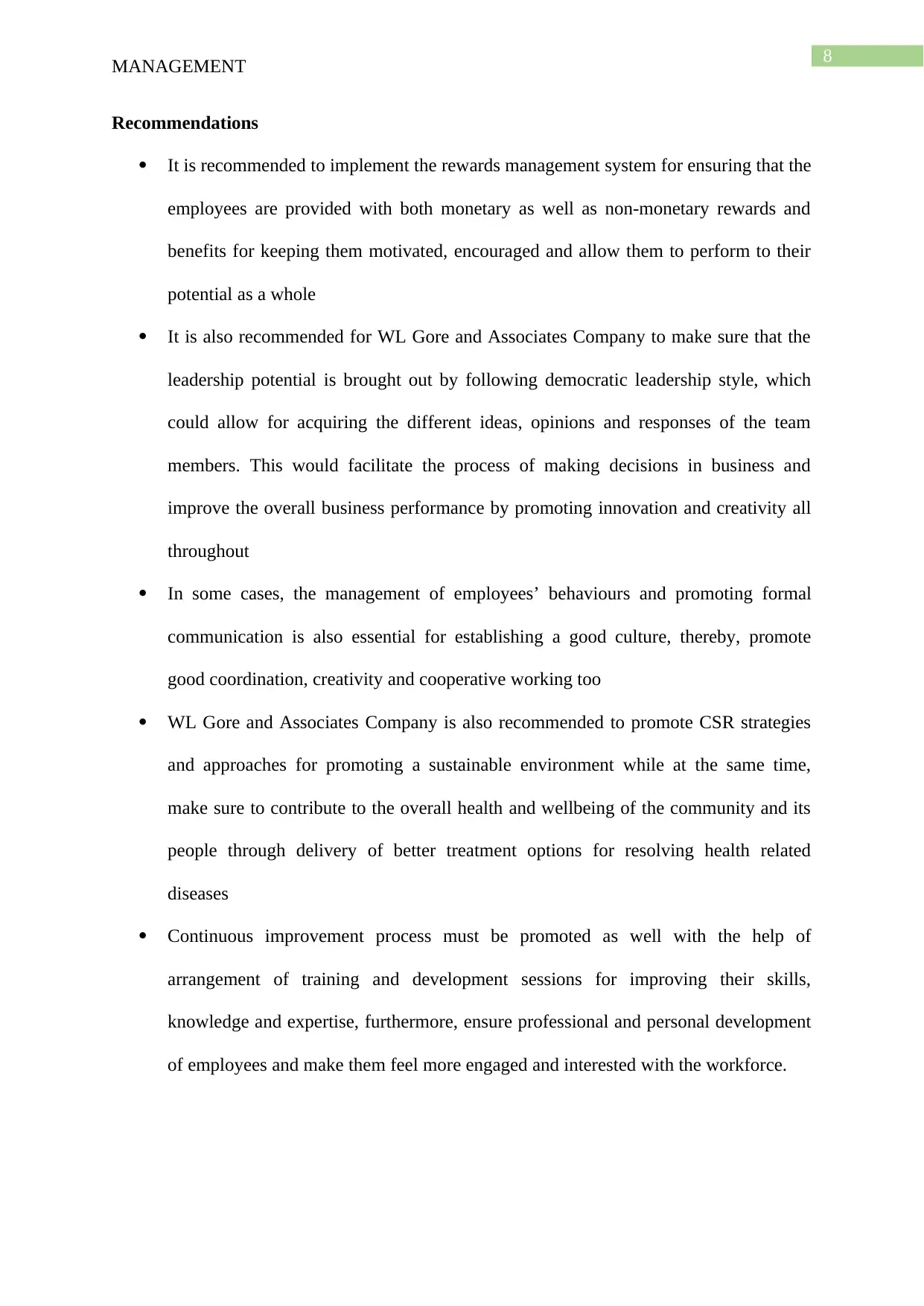
8
MANAGEMENT
Recommendations
It is recommended to implement the rewards management system for ensuring that the
employees are provided with both monetary as well as non-monetary rewards and
benefits for keeping them motivated, encouraged and allow them to perform to their
potential as a whole
It is also recommended for WL Gore and Associates Company to make sure that the
leadership potential is brought out by following democratic leadership style, which
could allow for acquiring the different ideas, opinions and responses of the team
members. This would facilitate the process of making decisions in business and
improve the overall business performance by promoting innovation and creativity all
throughout
In some cases, the management of employees’ behaviours and promoting formal
communication is also essential for establishing a good culture, thereby, promote
good coordination, creativity and cooperative working too
WL Gore and Associates Company is also recommended to promote CSR strategies
and approaches for promoting a sustainable environment while at the same time,
make sure to contribute to the overall health and wellbeing of the community and its
people through delivery of better treatment options for resolving health related
diseases
Continuous improvement process must be promoted as well with the help of
arrangement of training and development sessions for improving their skills,
knowledge and expertise, furthermore, ensure professional and personal development
of employees and make them feel more engaged and interested with the workforce.
MANAGEMENT
Recommendations
It is recommended to implement the rewards management system for ensuring that the
employees are provided with both monetary as well as non-monetary rewards and
benefits for keeping them motivated, encouraged and allow them to perform to their
potential as a whole
It is also recommended for WL Gore and Associates Company to make sure that the
leadership potential is brought out by following democratic leadership style, which
could allow for acquiring the different ideas, opinions and responses of the team
members. This would facilitate the process of making decisions in business and
improve the overall business performance by promoting innovation and creativity all
throughout
In some cases, the management of employees’ behaviours and promoting formal
communication is also essential for establishing a good culture, thereby, promote
good coordination, creativity and cooperative working too
WL Gore and Associates Company is also recommended to promote CSR strategies
and approaches for promoting a sustainable environment while at the same time,
make sure to contribute to the overall health and wellbeing of the community and its
people through delivery of better treatment options for resolving health related
diseases
Continuous improvement process must be promoted as well with the help of
arrangement of training and development sessions for improving their skills,
knowledge and expertise, furthermore, ensure professional and personal development
of employees and make them feel more engaged and interested with the workforce.
⊘ This is a preview!⊘
Do you want full access?
Subscribe today to unlock all pages.

Trusted by 1+ million students worldwide
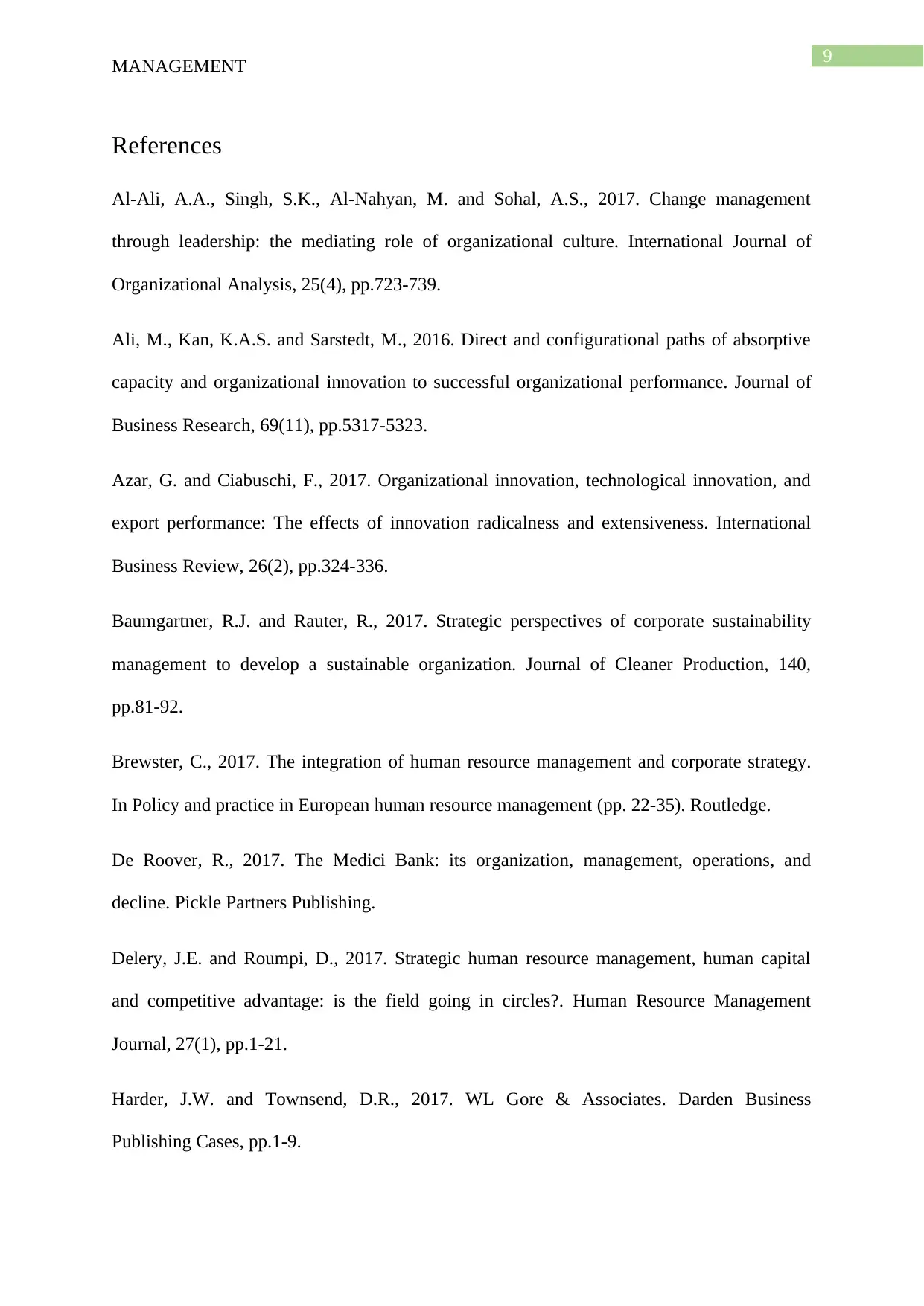
9
MANAGEMENT
References
Al-Ali, A.A., Singh, S.K., Al-Nahyan, M. and Sohal, A.S., 2017. Change management
through leadership: the mediating role of organizational culture. International Journal of
Organizational Analysis, 25(4), pp.723-739.
Ali, M., Kan, K.A.S. and Sarstedt, M., 2016. Direct and configurational paths of absorptive
capacity and organizational innovation to successful organizational performance. Journal of
Business Research, 69(11), pp.5317-5323.
Azar, G. and Ciabuschi, F., 2017. Organizational innovation, technological innovation, and
export performance: The effects of innovation radicalness and extensiveness. International
Business Review, 26(2), pp.324-336.
Baumgartner, R.J. and Rauter, R., 2017. Strategic perspectives of corporate sustainability
management to develop a sustainable organization. Journal of Cleaner Production, 140,
pp.81-92.
Brewster, C., 2017. The integration of human resource management and corporate strategy.
In Policy and practice in European human resource management (pp. 22-35). Routledge.
De Roover, R., 2017. The Medici Bank: its organization, management, operations, and
decline. Pickle Partners Publishing.
Delery, J.E. and Roumpi, D., 2017. Strategic human resource management, human capital
and competitive advantage: is the field going in circles?. Human Resource Management
Journal, 27(1), pp.1-21.
Harder, J.W. and Townsend, D.R., 2017. WL Gore & Associates. Darden Business
Publishing Cases, pp.1-9.
MANAGEMENT
References
Al-Ali, A.A., Singh, S.K., Al-Nahyan, M. and Sohal, A.S., 2017. Change management
through leadership: the mediating role of organizational culture. International Journal of
Organizational Analysis, 25(4), pp.723-739.
Ali, M., Kan, K.A.S. and Sarstedt, M., 2016. Direct and configurational paths of absorptive
capacity and organizational innovation to successful organizational performance. Journal of
Business Research, 69(11), pp.5317-5323.
Azar, G. and Ciabuschi, F., 2017. Organizational innovation, technological innovation, and
export performance: The effects of innovation radicalness and extensiveness. International
Business Review, 26(2), pp.324-336.
Baumgartner, R.J. and Rauter, R., 2017. Strategic perspectives of corporate sustainability
management to develop a sustainable organization. Journal of Cleaner Production, 140,
pp.81-92.
Brewster, C., 2017. The integration of human resource management and corporate strategy.
In Policy and practice in European human resource management (pp. 22-35). Routledge.
De Roover, R., 2017. The Medici Bank: its organization, management, operations, and
decline. Pickle Partners Publishing.
Delery, J.E. and Roumpi, D., 2017. Strategic human resource management, human capital
and competitive advantage: is the field going in circles?. Human Resource Management
Journal, 27(1), pp.1-21.
Harder, J.W. and Townsend, D.R., 2017. WL Gore & Associates. Darden Business
Publishing Cases, pp.1-9.
Paraphrase This Document
Need a fresh take? Get an instant paraphrase of this document with our AI Paraphraser
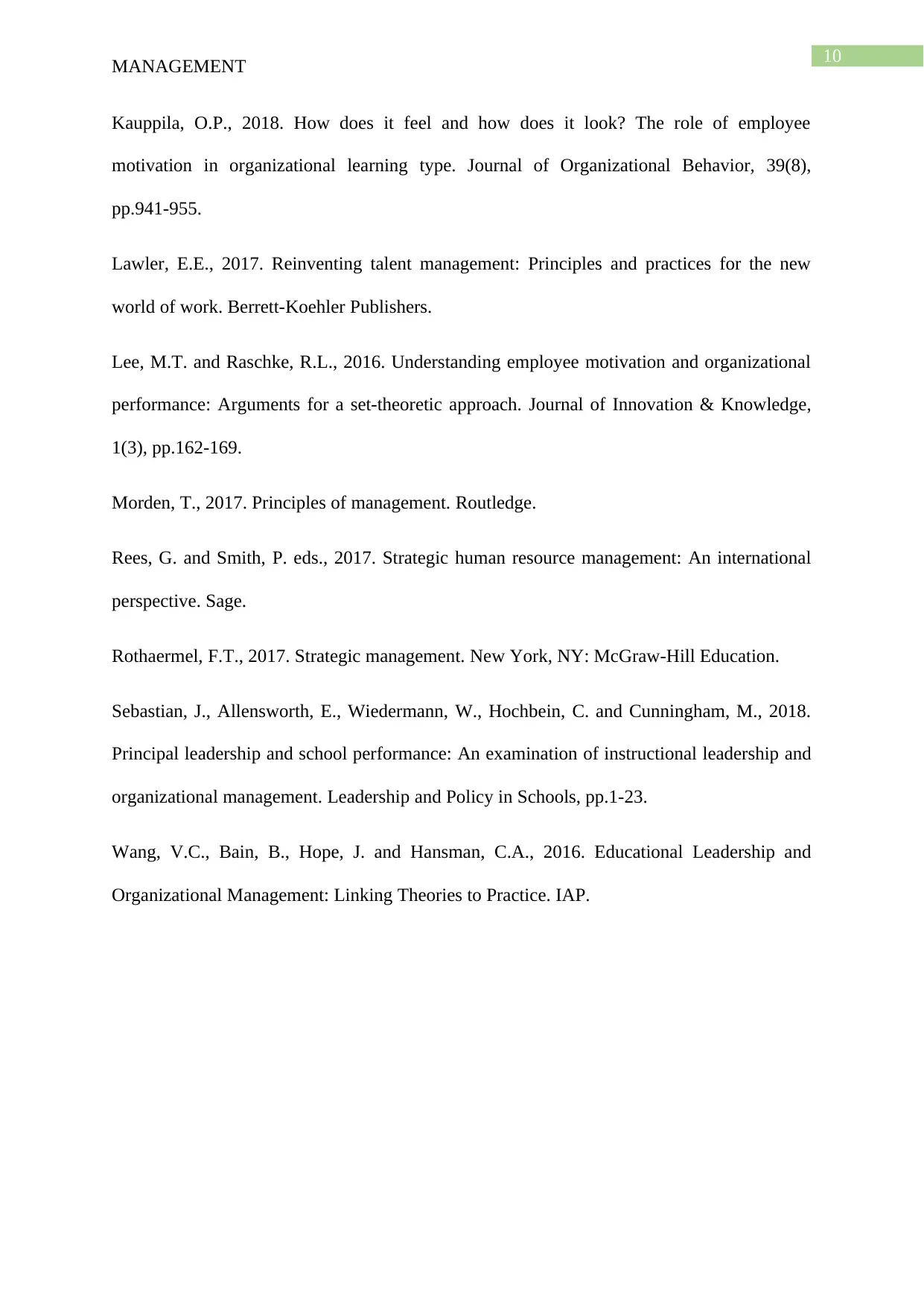
10
MANAGEMENT
Kauppila, O.P., 2018. How does it feel and how does it look? The role of employee
motivation in organizational learning type. Journal of Organizational Behavior, 39(8),
pp.941-955.
Lawler, E.E., 2017. Reinventing talent management: Principles and practices for the new
world of work. Berrett-Koehler Publishers.
Lee, M.T. and Raschke, R.L., 2016. Understanding employee motivation and organizational
performance: Arguments for a set-theoretic approach. Journal of Innovation & Knowledge,
1(3), pp.162-169.
Morden, T., 2017. Principles of management. Routledge.
Rees, G. and Smith, P. eds., 2017. Strategic human resource management: An international
perspective. Sage.
Rothaermel, F.T., 2017. Strategic management. New York, NY: McGraw-Hill Education.
Sebastian, J., Allensworth, E., Wiedermann, W., Hochbein, C. and Cunningham, M., 2018.
Principal leadership and school performance: An examination of instructional leadership and
organizational management. Leadership and Policy in Schools, pp.1-23.
Wang, V.C., Bain, B., Hope, J. and Hansman, C.A., 2016. Educational Leadership and
Organizational Management: Linking Theories to Practice. IAP.
MANAGEMENT
Kauppila, O.P., 2018. How does it feel and how does it look? The role of employee
motivation in organizational learning type. Journal of Organizational Behavior, 39(8),
pp.941-955.
Lawler, E.E., 2017. Reinventing talent management: Principles and practices for the new
world of work. Berrett-Koehler Publishers.
Lee, M.T. and Raschke, R.L., 2016. Understanding employee motivation and organizational
performance: Arguments for a set-theoretic approach. Journal of Innovation & Knowledge,
1(3), pp.162-169.
Morden, T., 2017. Principles of management. Routledge.
Rees, G. and Smith, P. eds., 2017. Strategic human resource management: An international
perspective. Sage.
Rothaermel, F.T., 2017. Strategic management. New York, NY: McGraw-Hill Education.
Sebastian, J., Allensworth, E., Wiedermann, W., Hochbein, C. and Cunningham, M., 2018.
Principal leadership and school performance: An examination of instructional leadership and
organizational management. Leadership and Policy in Schools, pp.1-23.
Wang, V.C., Bain, B., Hope, J. and Hansman, C.A., 2016. Educational Leadership and
Organizational Management: Linking Theories to Practice. IAP.
1 out of 11
Related Documents
Your All-in-One AI-Powered Toolkit for Academic Success.
+13062052269
info@desklib.com
Available 24*7 on WhatsApp / Email
![[object Object]](/_next/static/media/star-bottom.7253800d.svg)
Unlock your academic potential
Copyright © 2020–2025 A2Z Services. All Rights Reserved. Developed and managed by ZUCOL.




